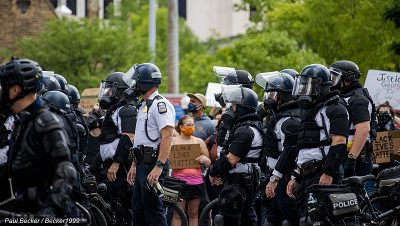Pentagon War Game Includes Scenario for Military Response to Domestic Generation Z Rebellion

In the face of protests composed largely of young people, the presence of America’s military on the streets of major cities has been a controversial development. But this isn’t the first time that Generation Z — those born after 1996 — has popped up on the Pentagon’s radar.
Documents obtained by The Intercept via the Freedom of Information Act reveal that a Pentagon war game, called the 2018 Joint Land, Air and Sea Strategic Special Program, or JLASS, offered a scenario in which members of Generation Z, driven by malaise and discontent, launch a “Zbellion” in America in the mid-2020s.
The Zbellion plot was a small part of JLASS 2018, which also featured scenarios involving Islamist militants in Africa, anti-capitalist extremists, and ISIS successors. The war game was conducted by students and faculty from the U.S. military’s war colleges, the training grounds for prospective generals and admirals. While it is explicitly not a national intelligence estimate, the war game, which covers the future through early 2028, is “intended to reflect a plausible depiction of major trends and influences in the world regions,” according to the more than 200 pages of documents.
According to the scenario, many members of Gen Z — psychologically scarred in their youth by 9/11 and the Great Recession, crushed by college debt, and disenchanted with their employment options — have given up on their hopes for a good life and believe the system is rigged against them. Here’s how the origins of the uprising are described:
Both the September 11 terrorist attacks and the Great Recession greatly influenced the attitudes of this generation in the United states, and resulted in a feeling of unsettlement and insecurity among Gen Z. Although Millennials experienced these events during their coming of age, Gen Z lived through them as part of their childhood, affecting their realism and world view … many found themselves stuck with excessive college debt when they discovered employment options did not meet their expectations. Gen Z are often described as seeking independence and opportunity but are also among the least likely to believe there is such a thing as the “American Dream,” and that the “system is rigged” against them. Frequently seeing themselves as agents for social change, they crave fulfillment and excitement in their job to help “move the world forward.” Despite the technological proficiency they possess, Gen Z actually prefer person-to-person contact as opposed to online interaction. They describe themselves as being involved in their virtual and physical communities, and as having rejected excessive consumerism.
In early 2025, a cadre of these disaffected Zoomers launch a protest movement. Beginning in “parks, rallies, protests, and coffee shops” — first in Seattle; then New York City; Washington, D.C.; Los Angeles; Las Vegas; and Austin — a group known as Zbellion begins a “global cyber campaign to expose injustice and corruption and to support causes it deem[s] beneficial.”
During face-to-face recruitment, would-be members of Zbellion are given instructions for going to sites on the dark web that allow them to access sophisticated malware to siphon funds from corporations, financial institutions, and nonprofits that support “the establishment.” The gains are then converted to Bitcoin and distributed to “worthy recipients” including fellow Zbellion members who claim financial need. Zbellion leadership, says the scenario, assures its members that their Robin Hood-esque wealth redistribution is not only untraceable by law enforcement but “ultimately justifiable,” as targets are selected based on “secure polling” of “network delegates.” Although its origins are American, by the latter 2020s, Zbellion activities are also occurring across Europe and cities throughout Africa, Asia, and the Middle East, including Nairobi, Kenya; Hanoi, Vietnam; and Amman, Jordan.
In the world of JLASS 2018, Gen Z’s most militant members have essentially taken to privately taxing large corporations and other institutions to combat income inequality or, as the war gamers put it, using the “cyber world to spread a call for anarchy.”
The JLASS war game emerges in the context of the Pentagon playing a controversial and visible role in the unfolding domestic protests against racism and police brutality in the U.S. National Guard units have been deployed in various locations already, and some active-duty military forces were sent by the Trump administration to the Washington D.C. area.
“I think the sooner that you mass and dominate the battlespace, the quicker this dissipates and we can get back to the right normal,” said Secretary of Defense Mark Esper earlier this week during a teleconference call that also saw President Donald Trump deride U.S. governors for their “weak” response to protests over the killing of George Floyd. Trump even declared that he had put Gen. Mark Milley, the chair of the Joint Chiefs of Staff, “in charge.” Later that day, after security forces drove protesters and clergy from Washington, D.C.’s Lafayette Square with tear gas, Milley, dressed in combat fatigues, followed Trump, Attorney General William Barr, Esper, and others to a roundly condemned photo op in front of St. John’s Episcopal Church.
This came amid the backdrop of threats being issued to employ active-duty military to forcefully suppress protests, and the deployment of rapid-reaction units from the 82nd Airborne Division to bases just outside Washington, D.C. With retired admirals and generals, among others, excoriating Trump — and to a lesser extent Esper and Milley — for breeches of long-standing norms in civilian-military relations, it’s worth considering how the Pentagon’s war gamers chose to focus the military’s attention on a generation now demonstrating peacefully in America’s streets.
*
Note to readers: please click the share buttons above or below. Forward this article to your email lists. Crosspost on your blog site, internet forums. etc.
Featured image is by Becker1999 from Grove City, OH / Wikimedia Commons

